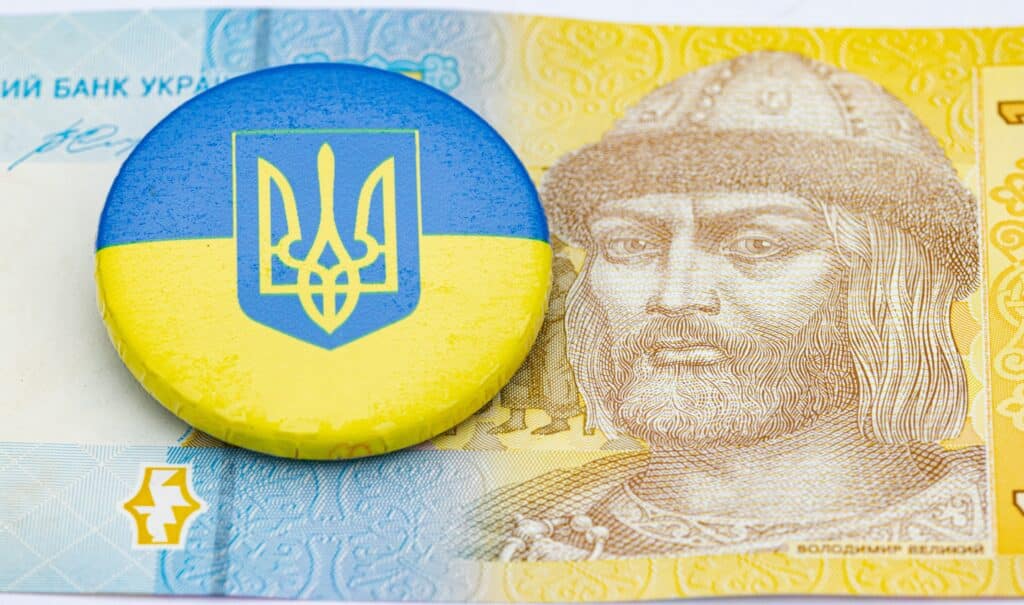The Ukrainian hryvnia is the official currency of Ukraine. Learn more about Ukraine’s currency in this guide, from essential facts to how to send money to Ukraine from abroad.
The hryvnia (currency code “UAH”) has been the official currency of Ukraine since September 1996. It is sometimes spelled “hryvna” or “gryvnya.” Its symbol is “₴,” though it is often indicated with the Cyrillic letters “грн.” The hryvnia is issued by the National Bank of Ukraine. Each hryvnia can be subdivided into 100 kopiyok.
Hryvnia currency comes in the form of coins and banknotes.
Coin denominations:
- 10 and 50 kopiyok
- 1, 2, 5, and 10 hryvnia
Banknote denominations:
- 1; 2; 5; 10; 20; 50; 100; 200; 500; and 1,000 hryvnia

Ukrainian Currency Facts
1. Ukrainian money has medieval roots.
The “kopiyok” is a Russian measure of weight that was used in medieval times in Kyivan Rus, which is the territory that would later come to be known as Russia. The term is centuries old, yet it still plays a role in Ukraine’s currency.
2. The word “hryvnia” pays homage to the old currency.
During the medieval period, “hryvnia” referred to a particular kind of neck jewelry. The word later came to represent a unit of weight. During challenging times in the 12th through 14th centuries, the region (then Kyiv Rus) did not mint coins; in their place, people used silver ingots again called “hryvnias.”
The term made its comeback during the Ukrainian Revolution when, in 1918, the Central Council introduced the hryvnia as a new unit of money.
3. The symbol of the hryvnia symbolizes stability.
The hryvnia sign “₴” gained its official status in 2004; its design won a public contest run by the National Bank of Ukraine. Much like the symbols for the euro, yen, and yuan, the hryvnia symbol includes two straight horizontal lines. The lines represent stability.
4. Hryvnia banknotes feature notable Ukrainians.
On paper banknotes, you’ll find the faces of important historical figures throughout the history of Ukraine. What makes the design different from many other currencies is that each note also depicts a historical landmark associated with that historical figure.
Some of the individuals honored on Ukrainian banknotes are poets and literary figures, including Ivan Franko, Taras Shevchenko, and Lesya Ukrainka. Quotes from their poetry are included on the bills featuring their portraits.

5. The bills were first printed in Canada.
Ukraine began to design its own currency in 1992. Because the country did not have its own paper mills, the currency was produced in Canada and the United Kingdom. In 1994, Ukraine launched its own paper mill, and in 1998, it founded its mint. Ever since then, the hryvnia has been produced exclusively in Ukraine.
About Ukraine
Ukraine is the second-largest country in Europe and has a population of about 40 million people. Its southern border is formed by the Black Sea, and it shares its land borders with Moldova, Romania, Hungary, Slovakia, Poland, Belarus, and Russia.
Ukraine’s capital, Kyiv, is also its largest city and home to nearly three million people. Most people in Ukraine speak Ukrainian.
Exchange Rates
To see the current exchange rate between Ukrainian hryvnia and U.S. dollars, check out today’s rate with Remitly

Sending Money to Ukraine
You can send money to Ukraine with Remitly. New customers may be eligible for a special offer on their first-time transfer. If you plan to send money to family or friends in Ukraine, consult the exchange price list and fees so you can send money over.